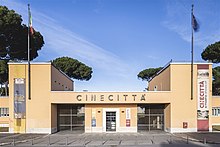
Back سينما أوروبا Arabic Cinema europeu Catalan سینەمای ئەورووپا CKB Europæisk film Danish Ευρωπαϊκός κινηματογράφος Greek سینمای اروپا Persian Eurooppalainen elokuva Finnish Cinéma européen French Európai film Hungarian Europos kinas Lithuanian

Cinema of Europe refers to the film industries and films produced in the continent of Europe. The history of Italian cinema began a few months after the French Lumière brothers, who made the first public screening of a film on 28 December 1895, an event considered the birth of cinema, began motion picture exhibitions.[2][3] The history of cinema in Germany can be traced back to the years of the medium's birth. Ottomar Anschütz held the first showing of life sized pictures in motion on 25 November 1894 at the Postfuhramt in Berlin.[4][5] On 1 November 1895, Max Skladanowsky and his brother Emil demonstrated their self-invented film projector, the Bioscop, at the Wintergarten music hall in Berlin. A 15-minute series of eight short films were shown – the first screening of films to a paying audience.[6]The first Italian director is considered to be Vittorio Calcina, a collaborator of the Lumière Brothers, who filmed Pope Leo XIII in 1896. The Lumière brothers established the Cinematograph; which initiated the silent film era, a period where European cinema was a major commercial success. It remained so until the art-hostile environment of World War II.[7] These notable discoveries provide a glimpse of the power of early European cinema and its long-lasting influence on cinema today.
Notable European early film movements include German expressionism (1920s), Soviet montage (1920s), French impressionist cinema (1920s), and Italian neorealism (1940s); it was a period now seen in retrospect as "The Other Hollywood". War has triggered the birth of Art and in this case, the birth of cinema.
German expressionism evoked people's emotions through strange, nightmare-like visions and settings, heavily stylised and extremely visible to the eye. Soviet montage shared similarities too and created famous film edits known as the Kino-eye effect, Kuleshov effect and intellectual montage.
French impressionist cinema has crafted the essence of cinematography, as France was a film pioneering country that showcased the birth of cinema using the medium invented by the Lumière brothers. Italian neorealism designed the vivid reality through a human lens by creating low budget films outside directly on the streets of Italy. All film movements were heavily influenced by the war but that played as a catalyst to drive the cinema industry to its most potential in Europe.
The notable movements throughout early European cinema featured stylistic conventions, prominent directors and historical films that have influenced modern cinema until today. Below you will find a list of directors, films, film awards, film festivals and actors that were stars born from these film movements.
- ^ "Cinecittà, c'è l'accordo per espandere gli Studios italiani" (in Italian). 30 December 2021. Retrieved 10 September 2022.
- ^ "L'œuvre cinématographique des frères Lumière – Pays: Italie" (in French). Archived from the original on 20 March 2018. Retrieved 1 January 2022.
- ^ "Il Cinema Ritrovato – Italia 1896 – Grand Tour Italiano" (in Italian). Archived from the original on 21 March 2018. Retrieved 1 January 2022.
- ^ "Ottomar Anschütz, Kinogeschichte, lebender Bilder, Kino, erste-Kinovorführung, Kinovorführung, Projektion, Kinoe, Bewegungsbilder".
- ^ "1886 Ottomar Anschütz - "Elektrischer Schnellseher"". YouTube. 22 October 2011.
- ^ Brockmann, Stephen (2010). A Critical History of German Film. Camden House. p. 13. ISBN 978-1-57113-468-4.
- ^ Rose of Sharon Winter (2008). "Cinema Europe: The Other Hollywood". Movies & TV Dept. The New York Times. Archived from the original on 5 September 2008. Retrieved 18 July 2013.